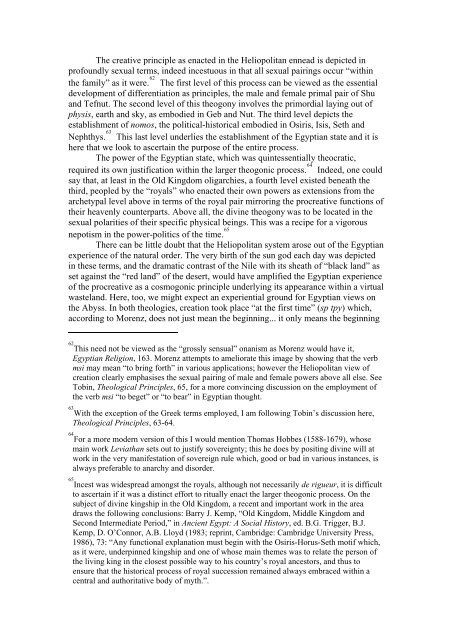THE EGYPTIAN FOUNDATIONS OF GNOSTIC THOUGHT
THE EGYPTIAN FOUNDATIONS OF GNOSTIC THOUGHT
THE EGYPTIAN FOUNDATIONS OF GNOSTIC THOUGHT
Create successful ePaper yourself
Turn your PDF publications into a flip-book with our unique Google optimized e-Paper software.
The creative principle as enacted in the Heliopolitan ennead is depicted in<br />
profoundly sexual terms, indeed incestuous in that all sexual pairings occur “within<br />
the family” as it were. 62<br />
The first level of this process can be viewed as the essential<br />
development of differentiation as principles, the male and female primal pair of Shu<br />
and Tefnut. The second level of this theogony involves the primordial laying out of<br />
physis, earth and sky, as embodied in Geb and Nut. The third level depicts the<br />
establishment of nomos, the political-historical embodied in Osiris, Isis, Seth and<br />
Nephthys. 63<br />
This last level underlies the establishment of the Egyptian state and it is<br />
here that we look to ascertain the purpose of the entire process.<br />
The power of the Egyptian state, which was quintessentially theocratic,<br />
required its own justification within the larger theogonic process. 64<br />
Indeed, one could<br />
say that, at least in the Old Kingdom oligarchies, a fourth level existed beneath the<br />
third, peopled by the “royals” who enacted their own powers as extensions from the<br />
archetypal level above in terms of the royal pair mirroring the procreative functions of<br />
their heavenly counterparts. Above all, the divine theogony was to be located in the<br />
sexual polarities of their specific physical beings. This was a recipe for a vigorous<br />
nepotism in the power-politics of the time. 65<br />
There can be little doubt that the Heliopolitan system arose out of the Egyptian<br />
experience of the natural order. The very birth of the sun god each day was depicted<br />
in these terms, and the dramatic contrast of the Nile with its sheath of “black land” as<br />
set against the “red land” of the desert, would have amplified the Egyptian experience<br />
of the procreative as a cosmogonic principle underlying its appearance within a virtual<br />
wasteland. Here, too, we might expect an experiential ground for Egyptian views on<br />
the Abyss. In both theologies, creation took place “at the first time” (sp tpy) which,<br />
according to Morenz, does not just mean the beginning... it only means the beginning<br />
62<br />
This need not be viewed as the “grossly sensual” onanism as Morenz would have it,<br />
Egyptian Religion, 163. Morenz attempts to ameliorate this image by showing that the verb<br />
msi may mean “to bring forth” in various applications; however the Heliopolitan view of<br />
creation clearly emphasises the sexual pairing of male and female powers above all else. See<br />
Tobin, Theological Principles, 65, for a more convincing discussion on the employment of<br />
the verb msi “to beget” or “to bear” in Egyptian thought.<br />
63<br />
With the exception of the Greek terms employed, I am following Tobin’s discussion here,<br />
Theological Principles, 63-64.<br />
64<br />
For a more modern version of this I would mention Thomas Hobbes (1588-1679), whose<br />
main work Leviathan sets out to justify sovereignty; this he does by positing divine will at<br />
work in the very manifestation of sovereign rule which, good or bad in various instances, is<br />
always preferable to anarchy and disorder.<br />
65<br />
Incest was widespread amongst the royals, although not necessarily de rigueur, it is difficult<br />
to ascertain if it was a distinct effort to ritually enact the larger theogonic process. On the<br />
subject of divine kingship in the Old Kingdom, a recent and important work in the area<br />
draws the following conclusions: Barry J. Kemp, “Old Kingdom, Middle Kingdom and<br />
Second Intermediate Period,” in Ancient Egypt: A Social History, ed. B.G. Trigger, B.J.<br />
Kemp, D. O’Connor, A.B. Lloyd (1983; reprint, Cambridge: Cambridge University Press,<br />
1986), 73: “Any functional explanation must begin with the Osiris-Horus-Seth motif which,<br />
as it were, underpinned kingship and one of whose main themes was to relate the person of<br />
the living king in the closest possible way to his country’s royal ancestors, and thus to<br />
ensure that the historical process of royal succession remained always embraced within a<br />
central and authoritative body of myth.”.










